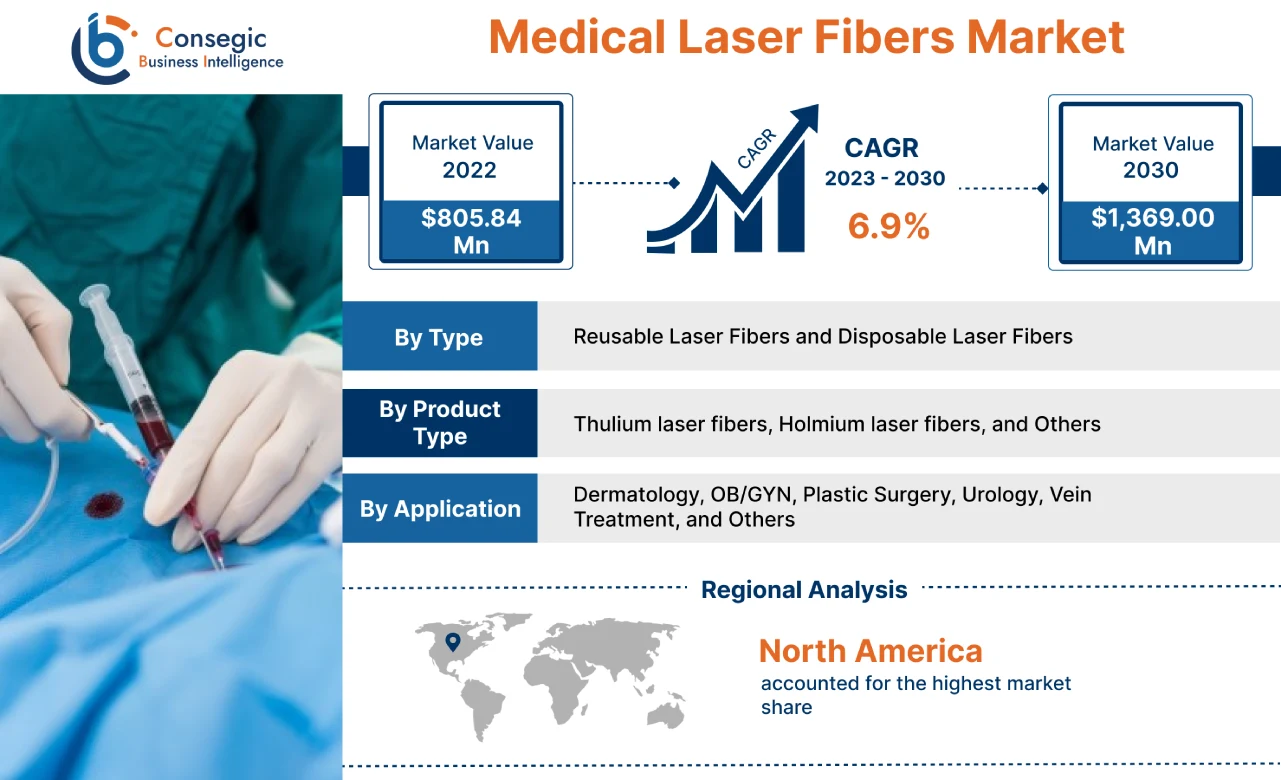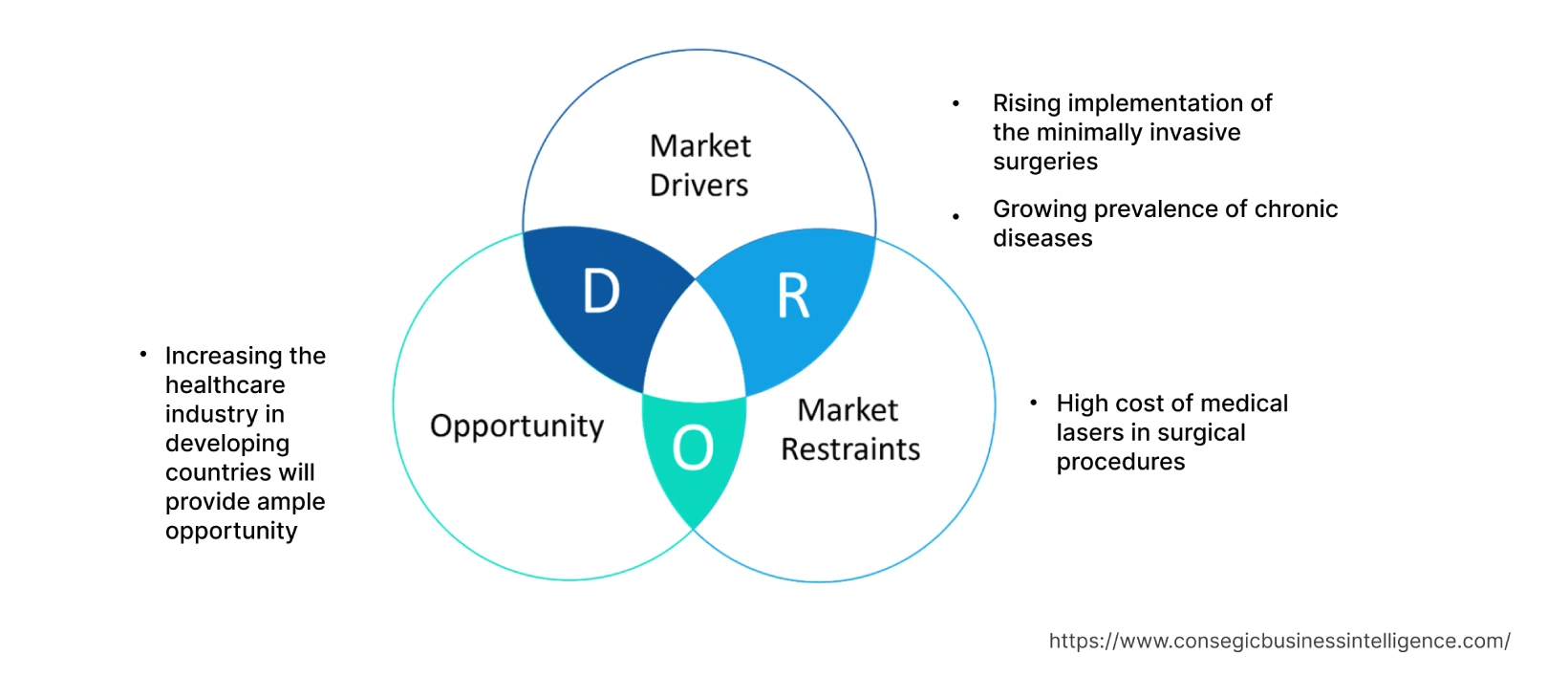Medical Laser Fibers Market Size :
Consegic Business Intelligence analyzes that the medical laser fibers market is growing with a CAGR of 6.9% during the forecast period (2023-2030), and the market is projected to be valued at USD 1,369.00 Million by 2030 from USD 805.84 Million in 2022.
Medical Laser Fibers Market Scope & Overview:
Medical laser fibers are flexible, thin strands of glass or plastic that are used to transmit laser energy to a surgical site. They are typically made of fused silica, which is a very transparent material that allows laser light to pass through it with minimal loss. Laser fibers are available in a variety of lengths, diameters, and tip shapes, depending on the specific application. The key advantage of the fiber laser is its contactless method, but its solidity, high efficiency, and easy use are necessary aids for medical applications.
Medical Laser Fibers Market Insights :
Medical Laser Fibers Market Dynamics - (DRO) :
Key Drivers :
Rising implementation of the minimally invasive surgeries
Medical laser fibers are a valuable tool for surgeons who perform minimally invasive surgeries. These fibers allow for precise delivery of laser energy to the target tissue, which can help to minimize tissue damage and scarring. Additionally, laser fibers can be used to cauterize blood vessels, which can help to reduce bleeding during surgery. Minimally invasive surgery continues to play a very important role in general surgery as an alternative to traditional open surgery and traditional laparoscopic techniques. The continuous development of the technical equipment allowed minimally-invasive surgery to develop from a distinct technique appropriate to operative interventions of low as well as mid-technical difficulty to reach very complex operative fields. The increase in the number of minimally invasive surgeries drives the demand for medical laser fibers. According to the National Institute of Diabetes, Digestive and Kidney Diseases endoscopic is the most common type of minimally invasive surgery in the U.S. with more than 20 million surgeries being performed each year.
Fiber lasers have developed as one of the trending topics in photonics in the last couple of years, specifically as the technology has developed in robustness as well as reliability. The highly productive along with good thermal management of fiber lasers make them mostly suitable for surgical applications. Thus, the growing adoption of minimally invasive surgeries drives market growth.
Growing prevalence of chronic diseases
Medical laser fibers are being investigated for a variety of potential applications in the treatment of chronic diseases. Laser fibers can be used to deliver high-intensity laser light to cancer cells, which can destroy the cells without harming surrounding tissue. This is being investigated as a potential treatment for a variety of cancers, including breast cancer, prostate cancer, and skin cancer. Chronic diseases are currently one of the major causes of death in adults globally and the toll is projected to increase by a further 17% in the next 10 years. Additionally, chronic diseases are on the rise globally and accounting for around 73% of all deaths. Fiber lasers offer high resolution, deep penetrations, and high contrast for applications that aid in medical evaluation. It is largely used for the treatment of chronic diseases. Thus, the above-mentioned factors drive market growth.
Key Restraints :
High cost of medical lasers in surgical procedures
Laser surgery is costly, preventing both developed as well as developing markets from applying the procedure. For example, in the U.S., the average cost of LASIK surgery was USD 2,246 per eye in 2019, which was slightly more costly than in 2018. The high cost associated with medical laser surgery procedures limits their adoption in emerging markets.
Future Opportunities :
Increasing the healthcare industry in developing countries will provide ample opportunity
Lower-middle-income countries account for around 90% of the global burden of disease. While only 12% of global spending on health occurs in these regions. Improving human health and providing access to cost-effective, high-quality health care is a key concern of all countries. Developing countries have made significant progress in the last two decades in improving health outcomes. Thus, the rising healthcare facilities in developing countries is expected to provide ample opportunity over the forecast period.
Medical Laser Fibers Market Report Insights :
| Report Attributes | Report Details |
| Study Timeline | 2017-2030 |
| Market Size in 2030 | USD 1,369.00 Million |
| CAGR (2023-2030) | 6.9% |
| By Type | Reusable Laser Fibers and Disposable Laser Fibers |
| By Product Type | Thulium laser fibers, Holmium laser fibers, and Others |
| By Applications | Dermatology, OB/GYN, Plastic Surgery, Urology, Vein Treatment, and Others |
| By Region | North America, Europe, Asia-Pacific, Latin America, and Middle East & Africa |
| Key Players | Clarion Medical Technologies Inc., Lumenis Be Ltd., biolitec AG, BD, Boston Scientific Corporation, Olympus Corporation, Cook, Richard Wolf GmbH, IPG Photonics Corporation, and Surgical Lasers Inc. |
Medical Laser Fibers Market Segmental Analysis :
By Type :
The type segment is categorized into reusable laser fibers and disposable laser fibers. In 2022, the reusable laser fibers segment accounted for the highest market share and is also anticipated to grow at a steady CAGR over the forecast period. Reusable fibers while being expensive up front, there is a huge potential for considerable savings, bringing costs down over time. Thus, the demand for the segment was large and dominated the market in 2022.
The disposable laser fibers are likely to grow at the fastest CAGR over the forecast period. This is due to the several advantages related to disposable laser fibers such as the economy of disposable laser fibers, increasing demand for non-invasive surgical procedures, and growing use of laser fibers in surgical procedures are the major factors expected to drive the segment growth. This type of laser fiber is mainly used in open surgery, urology, endoscopic surgery, laparoscopic surgery, and gynecology among others.
By Product Type :
The product type segment is categorized into thulium laser fibers, holmium laser fibers, and others. In 2022, the thulium laser fibers segment accounted for the highest market share of 48.05% in the overall medical laser fibers market. This is owing to the lesser stone retropulsion, improved endoscopic vision, and slightly enhanced stone-free rates. Additionally, it can provide high-power laser beams through small and more flexible fibers more effectually. Therefore, all these factors led to a high demand and large segment revenue in 2022.
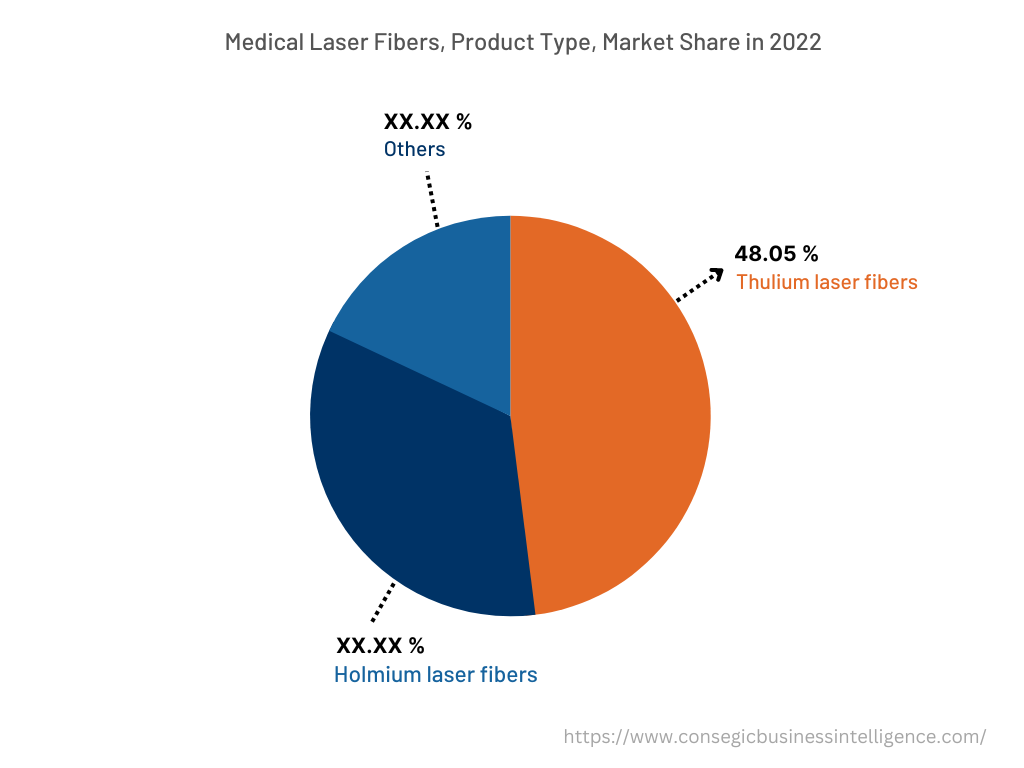
However, the holmium laser fibers segment is anticipated to grow at the fastest CAGR during the forecast period. This laser fiber has been the gold standard lithotrite for stone surgery over the past two decades. Several companies are offering an advanced product that is used for a variety of surgical procedures. For instance, Typenex Medical has the product named FibernexTM, a line of single-use along with reusable holmium laser fibers well-suited with holmium and Nd:YAG laser systems with standard SMA-905 fiber connections. Additionally, it can be utilized for various surgical uses such as open, coagulation, incision, excision, endoscopic ablation, and vaporization. Thus, the above-mentioned factor is likely to help the segment grow at the fastest CAGR over the forecast period.
By Application :
The application segment is categorized into dermatology, OB/GYN, plastic surgery, urology, vein treatment, and others. In 2022, the dermatology segment accounted for the highest market share in the overall medical laser fibers market. This is attributed to the growing number of cosmetic surgeries concurrently increasing the usage of medical lasers in these treatments and driving segment growth. Various companies operating in the market are investing in projects for the growth of the medical laser. For instance, in 2020, Cynosure LLC launched the Elite iQ platform, the next generation of the Elite+ aesthetic workstation that permits quick treatments with greater maximum energy than prior generation devices.
However, the plastic surgery segment is expected to grow at the fastest CAGR during the forecast period. This is owing to the factor that medical laser fibers have been used to treat several aspects of photoaged skin such as superficial rhytides, actinic keratoses, solar lentigines, and Favre-Racouchot disease. Additionally, its use in combination with topical 5-fluorouracil to treat keratoacanthomas and superficial basal cell carcinomas is increasing rapidly in the last couple of years.
By Region :
The regional segment includes North America, Europe, Asia Pacific, Middle East and Africa, and Latin America.
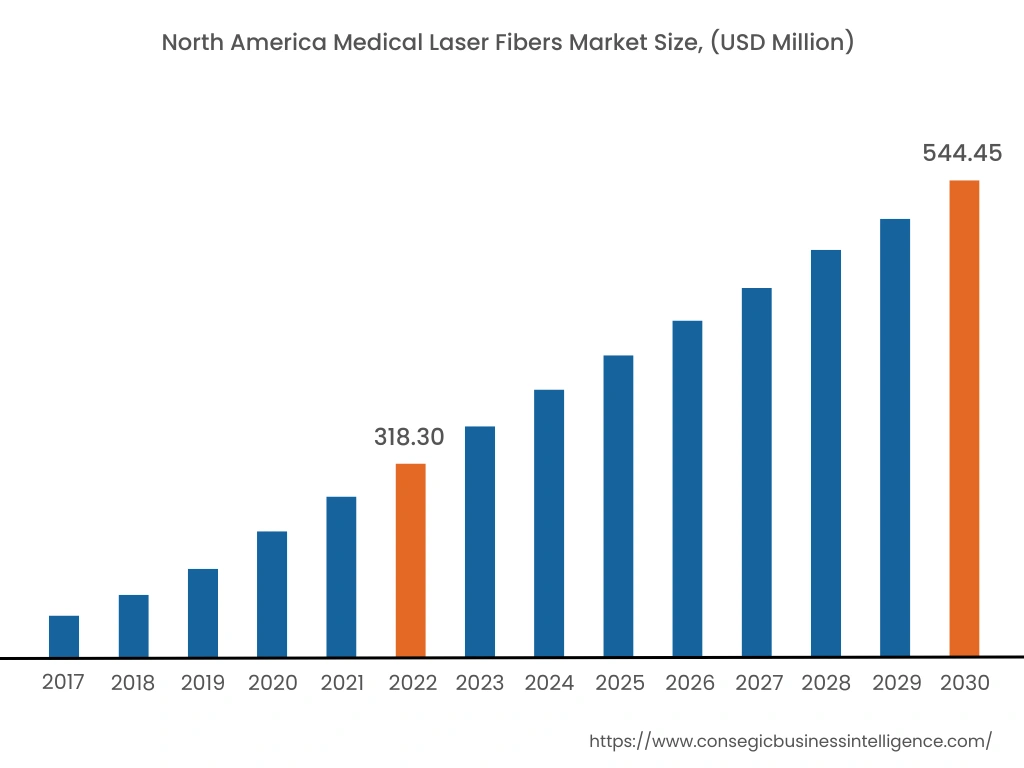
In 2022, North America accounted for the highest market share at 39.50% and was valued at USD 318.30 million, and is expected to reach USD 544.45 million in 2030. The increasing demand for MIS procedures, large preference for cosmetic procedures, and high implementation rate of novel technologies in the United States are the major factors responsible for regional growth. For instance, in 2020 according to the Oscular Surgery News, there was around a 42% rise in the number of laser vision correction procedures in Pacific Vision Institute as compared to 2019. Moreover, according to the American Society of Plastic Surgeons, in 2020 around 757,808 laser hair removal procedures were performed in the United States. All these factors led to the region's dominance in the global market.
Moreover, Asia Pacific is expected to grow at the fastest CAGR of 7.3% during the forecast period owing to the developing healthcare facilities and a rising number of laser centers. Additionally, growing demand for anti-aging treatment and a rise in the number of hair removal procedures are likely to grow the demand for medical laser fiber. For instance, in Japan and India around 3,87,793 and 97,920 hair removal procedures were performed in 2020. It is likely to increase over the forecast period.
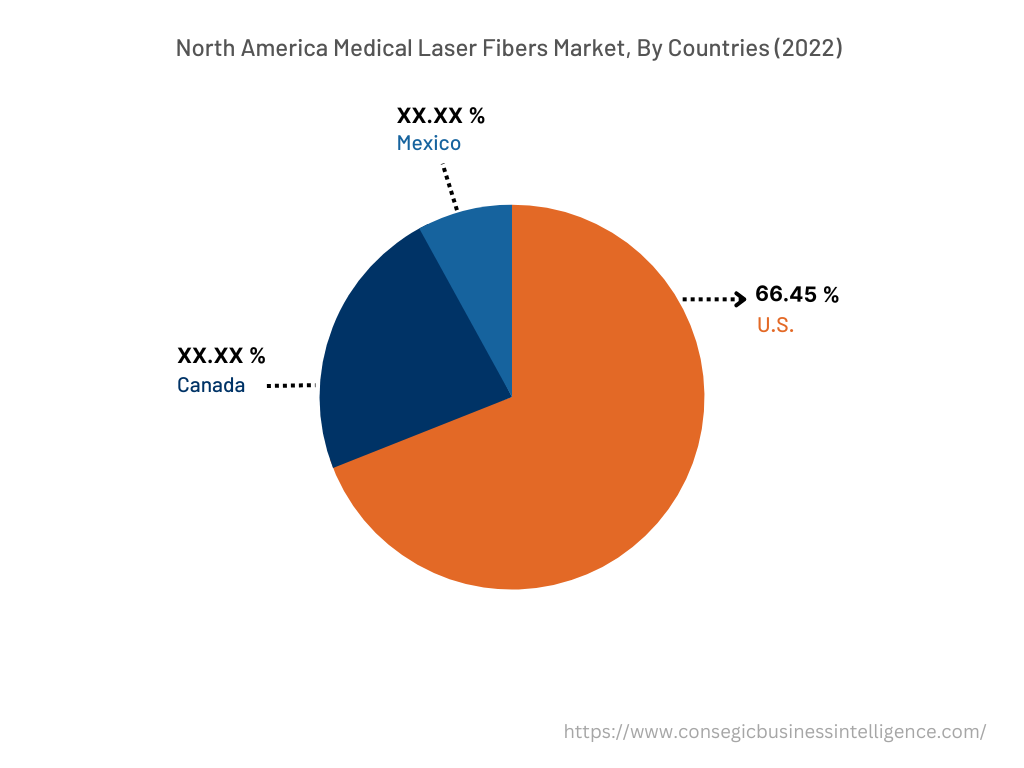
Top Key Players & Market Share Insights:
The medical laser fibers market is highly competitive, with several large players and numerous small and medium-sized enterprises. These companies have strong research and development capabilities and a strong presence in the market through their extensive product portfolios and distribution networks. The market is characterized by intense competition, with companies focusing on expanding their product offerings and increasing their market share through mergers, acquisitions, and partnerships. The key players in the market include-
- Clarion Medical Technologies Inc.
- Lumenis Be Ltd.
- Richard Wolf GmbH
- IPG Photonics Corporation
- Surgical Lasers Inc.
- biolitec AG
- BD
- Boston Scientific Corporation
- Olympus Corporation
- Cook
- KARL STORZ SE & Co. KG
Recent Industry Developments :
- In May 2021, Lumenis Ltd. announced a partnership with the prestigious Harrods Wellness Clinic. Harrods will equip its aesthetic clinic with the Stellar M22.
- In January 2021, OmniGuide Holdings, Inc. launched a new OTO-U CO2 laser system fiber. This fiber is used in ENT and otology surgeries and allows surgeons to reach narrow areas with more precision, resulting in enhanced procedures.
Key Questions Answered in the Report
What was the market size of the medical laser fibers market in 2022? +
In 2022, the market size of medical laser fibers was USD 805.84 million.
What will be the potential market valuation for the medical laser fibers market by 2030? +
In 2030, the market size of medical laser fibers is expected to reach USD 1,369.00 million.
What are the key factors driving the growth of the medical laser fibers market? +
The rising implementation of minimally invasive surgeries is fostering market growth.
What is the dominant segment in the medical laser fibers market by type? +
In 2022, the reusable laser fibers segment accounted for the highest market share in the overall medical laser fibers market.
Based on current market trends and future predictions, which geographical region will have the fastest impact on the medical laser fibers market's growth in the coming years? +
Asia Pacific is expected to be the fastest-growing region in the market during the forecast period.
